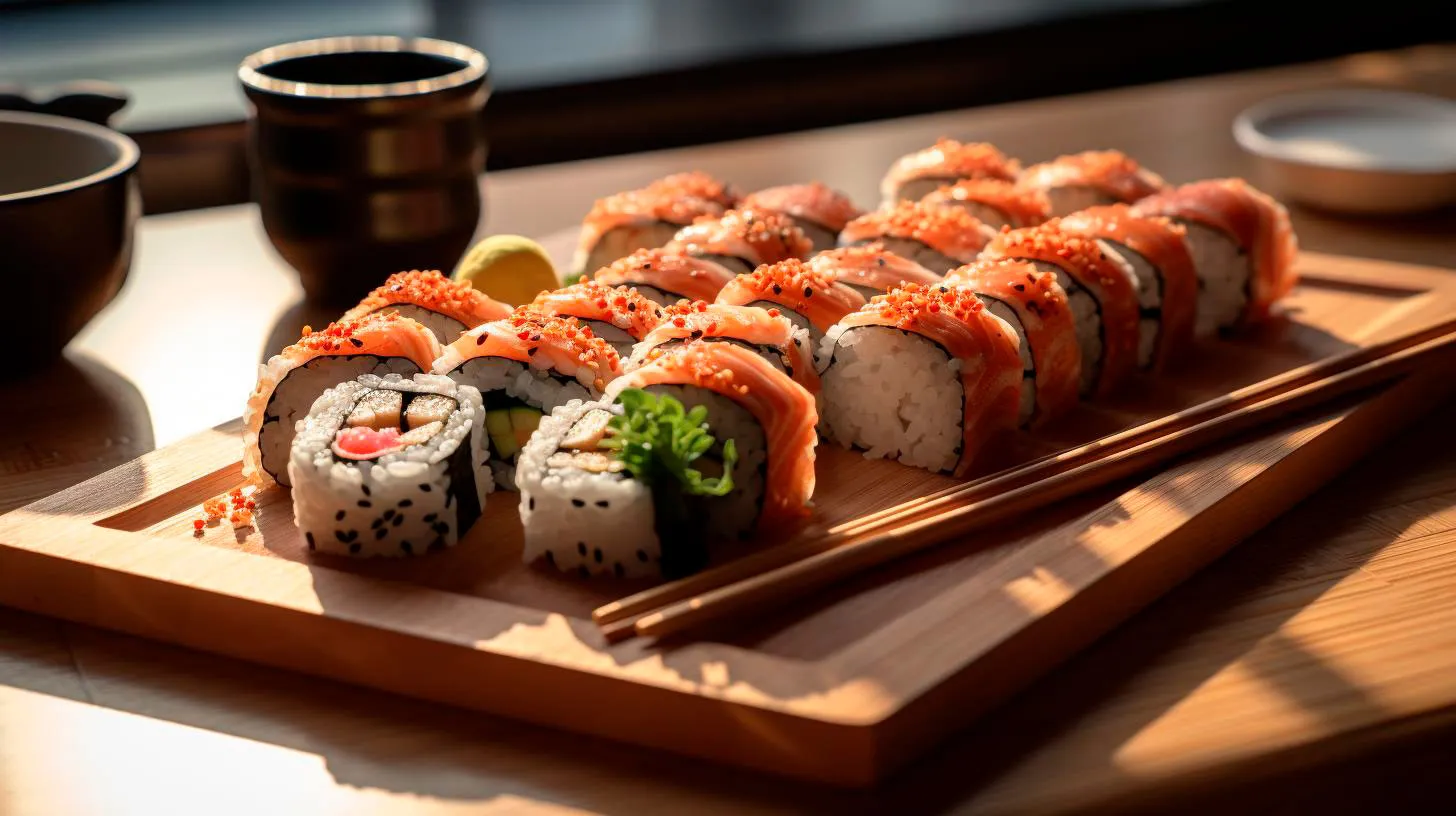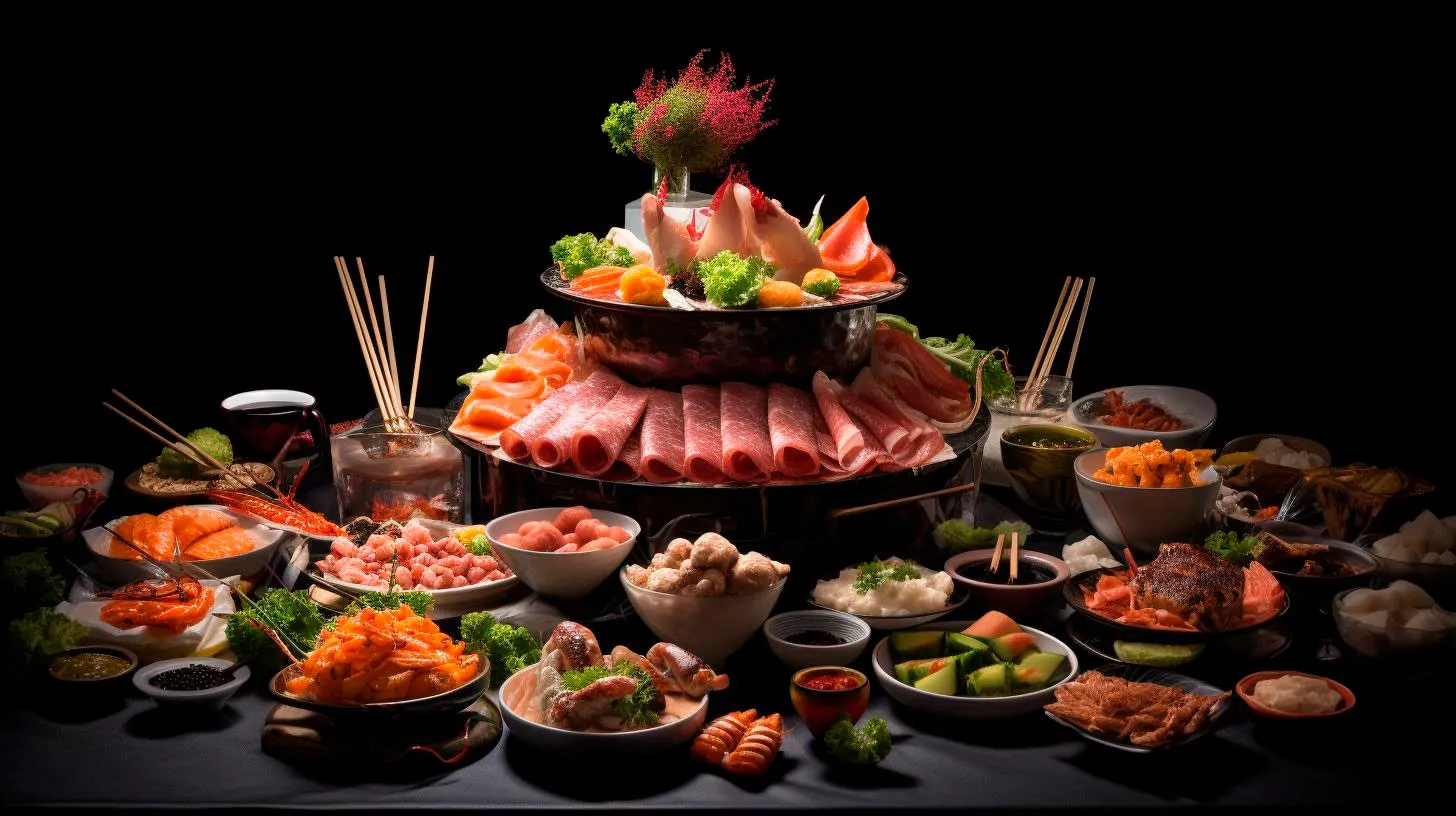Beyond the Basics: Exploring Unique Toppings for Nigiri Sushi
However, by trying out different toppings, you can elevate your sushi experience to a whole new level. In this article, we will delve into some extraordinary toppings that will surely leave you craving for more!
1. Uni (Sea Urchin)
Uni, the creamy sea urchin roe, is a lip-smacking delicacy that sushi lovers can’t resist. With its rich, buttery flavor and delicate texture, uni is often revered as the foie gras of the sea. The sweet and briny essence of this topping makes it an exquisite choice for nigiri sushi.
- Feature: Creamy and buttery flavor with a briny essence.
- Advantage: Adds a touch of decadence and sophistication to your sushi.
- Key Takeaway: Uni is a unique and indulgent topping that sushi connoisseurs adore.
2. Tobiko (Flying Fish Roe)
Tobiko, the vibrant orange fish roe, not only adds a pop of color to your sushi but also a burst of flavor. The tiny, crunchy eggs create a delightful sensation in your mouth. It comes in various flavors, including wasabi, yuzu, and squid ink, providing a wide range of options to suit your taste preferences.
- Feature: Vibrant, crunchy, and offers various flavor options.
- Advantage: Adds both visual appeal and a burst of flavor to your sushi.
- Key Takeaway: Tobiko is a versatile topping that adds an exciting twist to your nigiri sushi.
3. Ikura (Salmon Roe)
For seafood enthusiasts, ikura is a must-try topping for nigiri sushi. These plump, orange globules of salmon roe are bursting with a briny and slightly sweet flavor. The texture is delightfully satisfying, offering a juicy pop as you bite into them.
- Feature: Plump, juicy, and bursting with briny flavor.
- Advantage: Adds a unique textural experience and a burst of umami to your sushi.
- Key Takeaway: Ikura provides a delightful sensory experience for sushi enthusiasts.
4. Hotate (Scallops)
Scallops may not be the first thing that comes to mind when you think of nigiri sushi, but they are undoubtedly a delicious and indulgent choice. When perfectly seared or marinated, scallops offer a buttery and tender mouthfeel with a hint of sweetness. This topping is ideal for those who prefer a milder, yet flavorful option.
- Feature: Butteriness, tenderness, and a subtle sweet flavor.
- Advantage: Provides an alternative to the traditional fish toppings with a delightful taste profile.
- Key Takeaway: Scallops bring a touch of elegance and a unique flavor to your sushi.
5. Anago (Saltwater Eel)
If you’re looking for a cooked topping option, anago, or saltwater eel, is a fantastic choice for nigiri sushi. The soft and delicate texture of eel, along with its sweet and savory flavor, makes it an exquisite treat. The eel is often brushed with a delicious sauce that enhances its taste.
- Feature: Soft, delicate texture with a sweet and savory flavor.
- Advantage: Offers a cooked topping option for those who prefer their sushi warm.
- Key Takeaway: Anago provides a delightful contrast to the usual raw fish toppings.
By venturing beyond the basics and trying out these unique toppings, you can broaden your sushi horizons and discover new flavors that will keep you coming back for more. Remember, sushi is all about the experience, and exploring different combinations is part of the fun. So, the next time you visit your favorite sushi restaurant or try your hand at making sushi at home, don’t be afraid to go beyond the usual suspects and indulge in the extraordinary!
Masterful Pairings: How to Match Ingredients in Nigiri Sushi
Mastering these pairings requires an understanding of flavors, textures, and regional preferences. In this article, we will explore the art of matching ingredients in nigiri sushi, providing you with key insights and tips on creating the perfect bite.
The Role of Fish in Nigiri Sushi
The centerpiece of nigiri sushi is undoubtedly the fish. Opting for the freshest and highest quality fish is crucial to ensuring the overall taste and experience. Different types of fish offer unique flavors and textures, creating a diverse and memorable dining experience. Here are some popular fish used in nigiri sushi:
- Maguro (Tuna): With its rich, buttery taste and tender texture, maguro is a classic choice for nigiri sushi. It is best enjoyed with a touch of soy sauce and wasabi.
- Hamachi (Yellowtail): Known for its mild flavor and buttery texture, hamachi is a popular choice. Its delicate taste pairs exceptionally well with a squeeze of fresh lemon.
- Sake (Salmon): Sake offers a subtly sweet flavor and silky texture. Its vibrant color adds visual appeal to nigiri sushi. It pairs exceptionally well with a drizzle of soy sauce and a sprinkle of sesame seeds.
- Uni (Sea Urchin): For adventurous sushi enthusiasts, uni offers a unique, briny taste with a creamy, custard-like texture. Its distinct flavor calls for simple garnishes like a dash of sea salt or a squeeze of lemon.
These are just a few examples of the many fish options available. Remember, freshness is key when selecting fish for nigiri sushi. Consider sourcing your ingredients from trusted suppliers to ensure the highest quality.
Matching Flavors and Textures
While fish takes the spotlight, the rice and toppings play important supporting roles in nigiri sushi. The rice is seasoned with vinegar to provide a delicate, tangy flavor. It also serves as a base for the toppings, enhancing their flavors. Here are some key considerations when matching flavors and textures:
- Balance: Aim for a harmonious balance between the flavors of the fish, rice, and toppings. Each component should complement, not overpower, the others.
- Contrast: Experiment with contrasting flavors and textures when creating nigiri sushi. For example, pairing a rich, fatty fish like toro with a crispy garnish, such as tempura flakes, can result in an exciting combination.
- Regional preferences: Different regions in Japan have their own preferred ingredient pairings. Researching regional traditions and experimenting with these combinations can lead to unique and authentic nigiri sushi experiences.
Creating a balance of flavors and textures is an ongoing learning process. Explore different combinations, be open to experimentation, and take note of what works well together.
Key Takeaways
When it comes to nigiri sushi, the art of matching ingredients is crucial to achieve a memorable dining experience. Here are the key takeaways:
- Select fresh and high-quality fish for the best flavor and texture.
- Be mindful of balancing flavors between the fish, rice, and toppings.
- Experiment with contrasting flavors and textures to create exciting combinations.
- Research regional preferences to discover unique and authentic pairing ideas.
By understanding the role of each ingredient and considering flavor profiles, you can elevate your nigiri sushi-making skills and create memorable dining experiences. So, gather your ingredients, master the art of pairing, and impress your friends and family with your delectable nigiri sushi creations!
The Art of Nigiri Sushi: Selecting the Perfect Fish
In this article, we will delve into the art of nigiri sushi and explore the factors to consider when choosing the ideal fish for this traditional Japanese delicacy.
The Importance of Freshness
One of the key elements in creating exceptional nigiri sushi is the freshness of the fish. Sushi chefs consider freshness as their top priority when sourcing fish for their creations. Here are some reasons why freshness is crucial:
- Freshness ensures the best flavor and texture of the fish. The taste of nigiri sushi heavily relies on the quality and freshness of the fish used.
- Consuming sushi made with less than fresh fish increases the risk of foodborne illnesses. Fresh fish minimizes this risk and guarantees a safe dining experience.
- Fresh fish enhances the overall experience of nigiri sushi by offering a delightful aroma and a melt-in-your-mouth sensation.
Factors to Consider When Selecting Fish for Nigiri Sushi
Now that we understand the significance of freshness, it’s time to explore the essential factors to consider when choosing fish for nigiri sushi:
1. Sashimi Grade Fish
For nigiri sushi, it’s crucial to use sashimi grade fish. Sashimi grade fish ensures the highest quality, as it is carefully handled and frozen at low temperatures to kill any possible parasites. This level of quality is necessary to guarantee both safety and flavor in nigiri sushi.
2. Seasonality
In the world of sushi, seasonality plays a vital role. Certain fish species are more abundant and flavorful during specific times of the year. By choosing fish that is currently in season, you enhance the taste and freshness of your nigiri sushi. Stay up to date with seasonal fishing trends and take advantage of the bounties each season offers.
3. Texture and Flavor
The texture and flavor of the fish are paramount in nigiri sushi. Some fish varieties are known for their buttery and delicate texture, while others have a firmer and meatier consistency. Consider the desired mouthfeel and flavor profile when selecting fish for nigiri sushi, catering to the preferences of your guests.
4. Sustainability
Ensuring the sustainability of the fish you choose is essential to protect our oceans and marine life. Overfishing and destructive fishing practices pose a threat to the delicate ecosystem. As a responsible consumer, opt for fish that is sourced sustainably, minimizing your ecological impact.
Key Takeaways
Nigiri sushi is an art form that requires careful selection of the perfect fish. Here are the key takeaways to remember:
- Prioritize freshness to ensure the best flavor, texture, and safety of your nigiri sushi.
- Use sashimi grade fish to guarantee the highest quality and eliminate the risk of parasites.
- Consider the seasonality of fish to enhance the taste and freshness of your nigiri sushi.
- Pay attention to the texture and flavor profiles of different fish varieties, catering to your guests’ preferences.
- Support sustainability by choosing fish that is sourced responsibly, protecting our oceans for future generations.
The art of nigiri sushi lies not only in the skillful handcrafting of each piece but also in the thoughtful selection of the fish. By understanding the importance of freshness, considering seasonality, texture, and flavor, and promoting sustainability, you can elevate your nigiri sushi to new heights. Embrace the artistry of sushi and embark on a culinary journey that will delight your taste buds and leave you wanting more.
Elevating Your Nigiri Sushi Experience with Premium Ingredients
In this article, we will explore the importance of using premium ingredients in nigiri sushi and how it can enhance your dining experience.
The Importance of Freshness
One of the key aspects of nigiri sushi is the absolute freshness of the ingredients. Using premium, high-quality fish and seafood ensures that you’re getting the best flavors and textures. When the ingredients are fresh, the natural flavors shine, creating a delightful symphony on your taste buds.
- Using fresh fish ensures a clean, delicate taste that is brimming with umami.
- Fresh seafood guarantees a tender and succulent texture, enhancing the overall eating experience.
- High-quality ingredients contain essential nutrients and omega-3 fatty acids, benefiting your health.
By opting for premium ingredients, you are guaranteeing a more enjoyable sushi experience that showcases the true essence of nigiri sushi.
Flavor Profiles
Each type of fish or seafood used in nigiri sushi boasts its own distinct flavor profile. From the rich, buttery taste of fatty tuna to the delicate sweetness of scallops, every single bite is an opportunity to savor a unique explosion of flavors.
- Salmon offers a subtle, buttery taste with a hint of sweetness.
- Yellowtail delivers a bold and slightly fatty flavor with a touch of tanginess.
- Shrimp exhibits a sweet, succulent taste that pairs well with sushi rice.
By using premium ingredients, you can truly appreciate the depth and complexity of flavors that nigiri sushi has to offer.
Texture Matters
Aside from flavors, texture plays a crucial role in the overall enjoyment of nigiri sushi. The combination of the soft and slightly sticky rice with the tender fish or seafood creates a delightful contrast that keeps you coming back for more.
- A firm, slightly chewy texture is characteristic of octopus, providing a pleasant mouthfeel.
- Scallop offers a tender, buttery texture that melts in your mouth.
- Toro, or fatty tuna, is exceptionally tender and easily melts on your tongue.
Premium ingredients ensure that you are treated to the perfect balance of textures that make nigiri sushi an exceptional culinary experience.
Selecting the Best Ingredients
When it comes to selecting the best ingredients for your nigiri sushi, it’s essential to be mindful of a few factors:
- Source: Choose fish and seafood from reputable suppliers that prioritize freshness and sustainability.
- Quality: Look for vibrant colors, firm textures, and minimal odor, indicating freshness and high quality.
- Seasonality: Opt for ingredients that are in season, as they tend to be at their peak in terms of taste and quality.
By paying attention to these factors, you can elevate your nigiri sushi experience to new heights.
The Bottom Line
Nigiri sushi is a culinary art form that celebrates simplicity and provides an opportunity to appreciate the purest flavors of the sea. By using premium ingredients, you can enhance your dining experience, immersing yourself in a world of exquisite tastes and textures.
Remember, freshness and quality are paramount when it comes to nigiri sushi. By choosing high-quality fish and seafood, you embark on a gastronomic journey that showcases the essence of this beloved Japanese dish.
So, the next time you indulge in nigiri sushi, be sure to seek out premium ingredients. Your taste buds will thank you.



